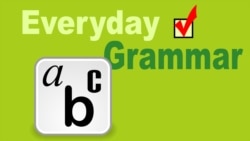North America is now in the fall season – a time of cooler temperatures, colorful leaves, and seasonal treats.
Fall is a season we describe in terms of colors and feelings. Yellow or orange leaves fill many trees. And people feel happiness or calmness when they walk outdoors.
In this week’s Everyday Grammar, we will explore the connection between fall and grammar. You will learn about how to describe fall through noun phrases, adjectives and determiners – markers of nouns.
Let’s start with a few important terms and ideas.
Noun phrases, adjective, determiners
Noun phrases are groups of words that act like a noun in a sentence. Noun phrases can appear as the subject of a sentence, or they can appear in the predicate – the part of the sentence that says something about the subject.
Consider the following statement:
A cool wind suggested the arrival of fall.
The words a cool wind make up a noun phrase and act as the subject of the sentence. In the sentence’s predicate, the words the arrival of fall are another example of a noun phrase.
Let us consider each of the words in a cool wind individually. Wind is a noun. Cool is an adjective. The word a is a determiner – it identifies the beginning of the noun phrase and tells whether it is general or specific.
Determiners can mark the beginning of noun phrases
Think of determiners as markers of nouns or noun phrases. They act like a sign to show that a noun is coming. These determiners mark the beginning of a noun phrase – much like the way changing leaves might mark the arrival of fall.
Determiners include words such as the, a, an, this, those. Some grammar books say some kinds of pronouns – his, her, their – act as determiners as well.
For example:
Their new tree has such beautiful leaves!
Determiners can help you identify nouns and adjectives
When you can identify determiners, your ability to identify nouns and adjectives will improve. And you will be better able to understand sentences in which you do not know the meaning of all of the individual words.
Imagine you are reading a book that describes the fall. You might read something like the following:
The -[blank]- leaves fell from the tree.
The sentence begins with the determiner the. Then there is the noun leaves. But what about the missing word?
You know that it is likely an adjective. It is a term that describes something about the noun. Ask yourself what kinds of adjectives usually describe leaves.
Now let’s add the word:
The radiant leaves fell from the tree.
You can probably tell that radiant means something close to bright or colorful. After all, the term is describing leaves. And leaves are generally described as bright or colorful.
But the sentence could have been different, as in:
The amber leaves fell from the tree.
In this case, amber means a color that is between yellow and orange. But still, the adjective connects with the general idea of light and color.
What if you don’t see a determiner?
All the examples we have explored use a determiner to mark the beginning of a noun phrase.
But English sentences do not always have such words.
Consider the following statement:
Large pumpkins lined the road.
In this case, the subject is large pumpkins – a noun phrase that consists of an adjective, large, and a noun, pumpkins.
Still, the general idea is that the adjective comes before the noun.
The next time you read in English, pay careful attention to how the writers use determiners, adjectives and noun phrases. Note when determiners are present and when they are not.
With time, you will use adjectives, noun phrases and determiners to create your own descriptions – perhaps of a happy fall day, perhaps of another time altogether.
I’m John Russell.
John Russell wrote this lesson for Learning English. Susan Shand was the editor.
_____________________________________________________________
Words in This Story
fall – n. the season between summer and winter : the season when leaves fall from trees
grammar – n. the entire system and structure of a language
specific – adj. precise or exact
pumpkin – n. a large, round, orange vegetable used as food and sometimes as a decoration








